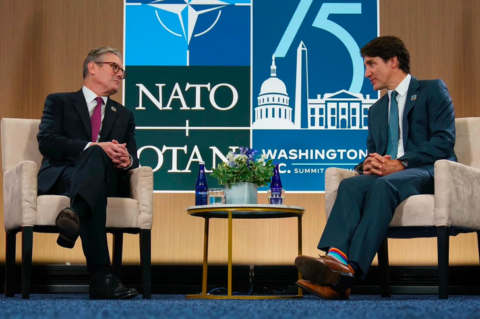A rare appearance of a Matt Gurney column outside the paywall at The Line explains why the Prime Minister couldn’t resist the temptation to attack Pierre Poilievre on the national security file, despite the fact that it gives Poilievre a strong counterattack:

Prime Ministers Starmer and Trudeau at the NATO summit in Washington.
Image from Justin Trudeau’s X account.
What Justin Trudeau did on Wednesday from the witness standing at the foreign interference inquiry — when he made his dramatic announcement of having seen a list of Conservatives who are compromised by or vulnerable to foreign interference — makes a kind of sense.
It does. It was an effective attack on Pierre Poilievre, who has stubbornly led with his chin for months. The reaction of many of my Conservative friends was telling. They knew Trudeau landed a hit, and they were pissed. They were ready for it — I think their counterattack was as good or better. But this whole story, or at least this little snippet of it, starts with Trudeau taking a swing, and not missing.
[…]
In that context, Trudeau’s decision to tease the possibility of some unnamed Conservatives being involved in the machinations of foreign interference makes sense. He saw Poilievre’s chin and decided to shove his fist into it. It’s politics. I get it.
But, once again, I’m not sure that the PM thought this through all the way. Our PM has a habit of occasionally letting his combative instincts get the better of him. The man has a weakness for showy, dramatic gestures, and loves to try and seize the big moments. Sometimes they blow up in his face. I think this one will, too. It is, I suspect, less a punch to the face, and more of an elbow-to-the-boob. It’ll cause more problems than the gesture was worth.
[…]
Trudeau doesn’t get a lot of opportunities to look like a tough leader these days, and he got two this week. His eviction of six Indian diplomats that Canadian intelligence believes were involved in guiding violent crimes in Canada, aimed at politically connected members of Canada’s large Indian diaspora, was one (and I am not yet cynical enough to believe the timing was politically motivated). The second, of course, was Trudeau’s bombshell testimony. Given the shellacking he’s been taking of late, it probably felt amazing [to] go on the attack yesterday.
The problem for the prime minister is that, today, having had his dramatic moment, there’s no follow through. He dropped the mic and then Poilievre did what he was always and obviously going to do: the opposition leader picked that mic right back up again and started talking into it.
Here’s part of Poilievre’s statement (full statement is here):
My message to Justin Trudeau is: release the names of all MPs that have collaborated with foreign interference. But he won’t. Because Justin Trudeau is doing what he always does: he is lying. He is lying to distract from a Liberal caucus revolt against his leadership and revelations he knowingly allowed Beijing to interfere and help him win two elections. … If Justin Trudeau has evidence to the contrary, he should share it with the public. Now that he has blurted it out in general terms at a commission of inquiry — he should release the facts. But he won’t — because he is making it up.
If Poilievre’s decision to forgo a security clearance is overly complicated and technocratic, then Trudeau’s decision to attack him for it suffers the same drawbacks. By comparison, Poilievre’s approach, here, is better, simpler, and most crucially, it’s right: Release the names!
If MPs from any party have been compromised, the public deserves to know.
I don’t say that lightly or impulsively. There are absolutely downsides to releasing the names, including the very real risks to compromising our investigations and destroying the reputations of people who may have committed no crime. This sucks. But there are greater downsides to not releasing the names — until the Canadian public knows them, our entire democratic system is suspect. To put it another way, if it is inappropriate to release the names in full, then it is equally if not more inappropriate for a prime minister to publicly tease those names during his testimony, while hiding behind oaths of national security in order to avoid handing over the receipts. Protections of “national security” are intended to protect real sources and reputations — not to serve as a launchpad to lob allegations at foes while dodging accountability and transparency.





